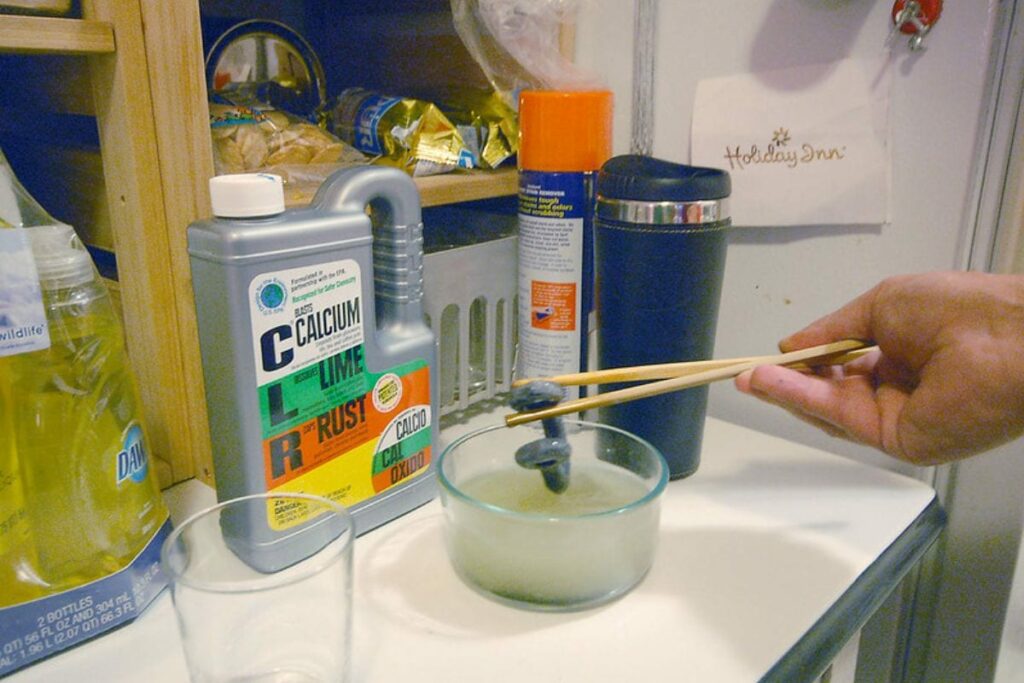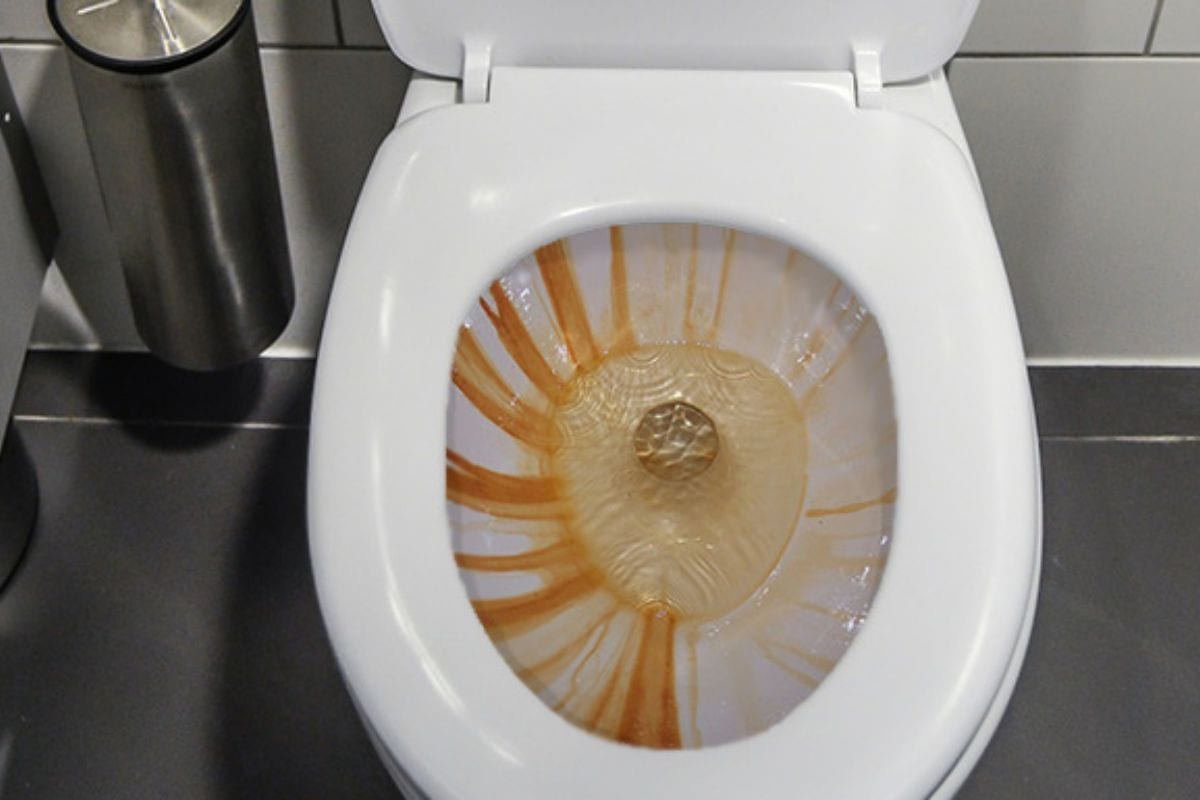Hard water can leave a white crust or orange rust-like residue on everything water touches. It can look particularly bad in a toilet because it looks like the toilet is clean when it is in fact dirty. It’s possible to prevent hard water stains before they begin to accumulate, and in this article, I will explain how to do it.
As a general rule, the only option is to install a water softener at the mains. A water softener will remove hard water deposits from the water supply as it enters your home. Other than that, the only other option is to clean your toilet regularly with CLR or a similar product.
There are also specialist water tanks specifically for the toilet only. Below, I will explain how a water softener works, how costly it is to install one, and a method to remove hard water stains easily and quickly.
How a Water Softener Works and Where They’re Installed

A water softener has specially made electrostatically charger plastic beads. When the mineral deposits come in contact with them the hard water atoms such as calcium, and metals react chemically with the plastic beads and stick to them. This removes them completely from the water.
Once, the plastic beads become full of the minerals and metals that are in hard water, they are washed in a brine solution. This removes the hard water deposits from the plastic beads, and they fall to the bottom of a water softener where they are pumped out with the wastewater.
Brands like Kinetico provide water softeners. One for the entire home costs about $5,000. Whereas, a one-for-one part of the house such as the toilet or shower costs $500 and up. The more expensive a water softener is the more water it can soften.
Cleaning your toilet once a week with specialist cleaners
There are a range of cleaners that are specifically designed to remove hard water deposits. A good example, that is quite well known in CLR. Which stands for Calcium, Lime, and Rust. Lime is short for limestone.

White hard water deposits are directly caused by dissolved limestone in the water. And rust is caused by dissolved metals in the water. Another very effective option is vinegar. Vinegar is well known for removing hard water deposits.
Of all the different types of vinegar, sherry vinegar is the strongest. But, it’s still not strong enough to damage your toilet in any way. The main thing to watch out for is pouring it into the water tank at the back of your toilet.
There are a range of components in the water tank that are made of rubber and plastic. If you wash them with vinegar they can wear away slowly over time. And will mean you will need to replace them sooner.
Therefore, you should limit using vinegar to the bowl only. The ways to use vinegar to remove hard water deposits in a toilet are to:
- Remove as much of the water from the bowl using a disposable plastic cup or similar.
- Pour vinegar into the bowl
- Let it sit for 3 to 6 hours
- Scrub it using a hard-bristled plastic brush
The vinegar will dissolve the hard water deposits in a toilet, according to plumbers. There can often be a ring of visible hard water deposits. It forms where the water in the bowl rises to and stays after your toilet flushes. It’s often necessary to use a lot of vinegar to fill up the bowl enough to completely cover up to this line.

Depending on how thick the hard water deposits are, it can often take quite a bit of scrubbing – about 2 minutes – to completely remove it. Therefore, you should do it as soon as you notice hard water deposits forming. Rather than letting it build up and become thicker.
If it’s particularly thick, you do this method twice. Removing half of the deposits the first time, and the other half the second time. The hard water deposits underneath the surface of the hard water deposits, won’t be touched by the vinegar. So the acid in the vinegar won’t be able to soften and weaken it.
What Causes Hard Water Stains in a Toilet
Hard water stains don’t occur in all cities or towns. Therefore, it can be a bit confusing why they occur in some areas and not others. Here’s what causes hard water stains to form in a toilet.
Overall, it’s caused by dissolved elements in the water. Rocks like limestone and igneous rocks like basalt have calcium, and metals in them. These dissolve and are suspended in water. Anytime hard water touches the toilet a small amount of these elements sticks to the bowl.
Once these elements dissolve they are so small that they are typically not visible to the naked eye. But, after some time enough accumulates that it becomes visible. Calcium deposits are white in color. Whereas, metals begin to oxidize (rust), and turn orange, or don’t rust and leave a gray or black residue.
Water accumulates in aquifers, where rainwater trickles into cracks in the rock underground where it is pumped out. Or washes down in rivers from higher elevations. Water is collected from rivers directly. As the water runs over rocks, a small amount of the minerals in the rock dissolve and are suspended in water.
What Is the Best Cleaner for Hard Water Stains in a Toilet
Various cleaners are better at cleaning some things compared to others. Some cleaners can also damage some surfaces. Here’s the best cleaner to clean hard water stains from a toilet.
Overall, vinegar is the best cleaner for cleaning hard water stains on a toilet. Hard water stains are composed of calcium or metals. Vinegar is a mild acid that eats away at the hard water deposits and makes them soft. Ideally, dry the affected area before applying the vinegar.
Drying the area allows the vinegar to make more contact with the hard water stains. For a toilet bowl, you can scoop out the water using a disposable cup or similar. It’s also best to let the vinegar sit on the deposits for about 30 minutes.
This can be done by putting wetting toilet paper in vinegar and then putting it on the hard water stains. A single layer of toilet paper will stick to the sides of the bowl.

Amos Christen graduated with a bachelor’s degree in Interior Design from Drexel University — Philadelphia, PA. Since 2003, Amos has worked with top interior design professionals in this area, including architects and interior/graphic/lighting designers. As a skilled interior designer, Amos Christen is highly versed in fine arts and crafts and uses that to supplement his main area of expertise. He often publishes articles related to home décor on several websites, including Sprucetoilets.com, Sprucebathroom.com, and Mybesuitedhome.com. He also contributes to leading interior design magazines.
